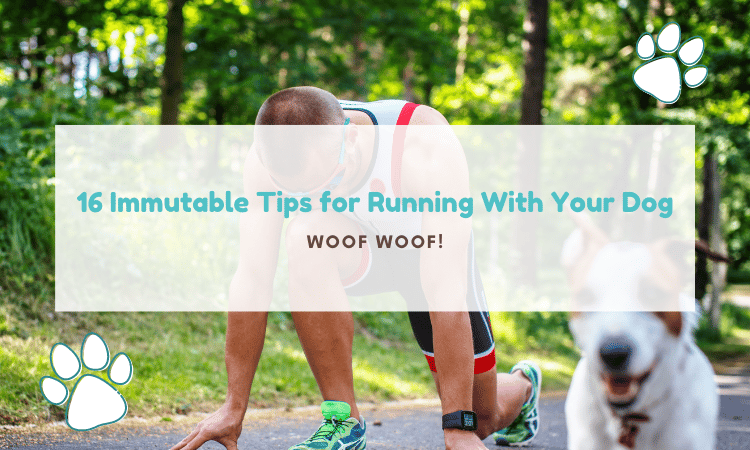Did you know that running with your dog offers benefits beyond fitness? When you have a furbaby, you have a built-in exercise partner, and sharing the activity enhances your experience in many ways:
- It boosts your senses. You’ll be more attentive to what’s going on around, and that results in an improved reaction time and enhanced training effect.
- It breaks up the monotony of running. Because you’ll have to adjust to your pup’s pace changes, your outing will be more dynamic and increase your overall performance.
- It helps you to plan ahead. When you bring Fido along, you need to think about your route in advance. Advanced planning allows you to get more from your workouts.
- It adds protection. Running with your furbaby means that you have a built-in bodyguard by your side.
- It can increase your motivation. So, even when you don’t feel like it, your furry friend can provide that added incentive to get out there.
Before you grab the harness and head out the door with Fido, let’s talk about some tips to help you and your furbaby stay safe and get the most out of your workouts.
Consult Your Vet First
Before including your pooch in your running program, check with your veterinarian. Different dog breeds have different growth and maturity patterns. Fido’s doctor can help you determine a safe age to begin training your puppy and how far he can run. And your vet should also know if your furbaby has any underlying medical conditions that make running risky for him.
Know Your Pal’s Exercise Requirments
Different classes of dogs have different energy levels and exercise requirements. If you want to take your pal running with you, you need to understand his breed exercise requirements.
- Sporting breeds like retrievers and spaniels are energetic pups that need 70-135 minutes of exercise a day.
- Toy breeds such as Pomeranians and Chihuahuas require 30-60 minutes each day. These pups are best for light runs due to their short legs.
- Working breeds, like the sporting breeds, have plenty of vigor and thrive on 70-135 minutes of activity per day. Examples of this group include Burmese mountain dogs and Great Danes.
- Herding breeds like shepherds and collies originated from the working group and need 65-130 minutes per day of exercise.
- Terriers are another high energy group that requires about 50-95 minutes of activity per day.
- Hounds, similar to the sporting and working groups, possess the stamina and vigor for extended periods of activity and need about 70-135 minutes of exercise.
Know The Best Age to Start Running With Your Dog
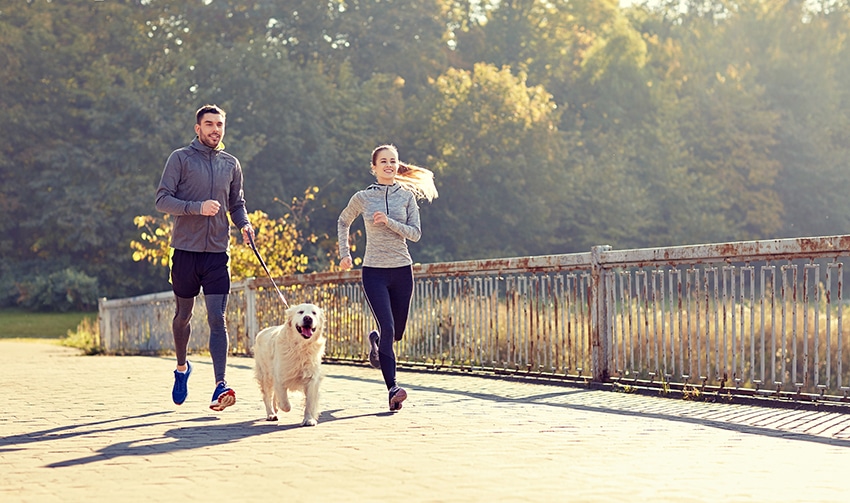
When you start will depend on the kind of dog that you have. Forced running(more on this later) with puppies can damage their growth plates and cause medical issues down the road. That’s why it’s important that you know when it’s safe to start jogging with your furbaby.
Growth plates are the cartilaginous parts of juvenile bones that continue to grow until a person or animal reaches adult size. The average age that growth plates close is about 1 year. For some toy breeds, it may close as early as 8 months, while it can take up to 18 months for giant breeds.
Before you begin training your four-legged friend to jog with you, schedule a visit with your veterinarian. The doctor can take radiographs to confirm that the growth plates have closed.
What’s forced running, you ask? That simply means that you’re making your dog run with you at your pace without any breaks. It’s different from the running that pups do when left to their own devices. When your pal goes to the park or plays in the back yard, he can dash around at will. But he’s also free to take breaks and rest any time he needs.
Start With Training
If you want a well-behaved pooch on the trail, you’ll need to train him on how to run with you. The first step is learning how to walk agreeably on a leash. It’s no fun to jog with a dog that’s constantly tugging at his lead.
Go slowly for your first couple of outings with Fido. Don’t start with much running until your pal knows how to mind you. Teach him a cue word that indicates you’re ready to pick up the pace, like, “let’s go!”
Begin with light jogging in an area that has minimal disturbances. A few laps around an outdoor track or quiet park is a good starting point. Once you master the basics, you can try other venues that have more distractions such as other dogs and people.
Over time, you’ll be able to build a comfort level until you and your pooch are able to run your course together without fear of interruptions. At this point, it will be no different than going for a walk except that your pace will be faster.
Teach Transitional Cues
Chances are you’ve already taught your dog cues for basic obedience such as sit, stay, and down. Likewise, when you train your furbaby to run with you, giving them verbal cues can prove useful.
By teaching your furbaby words such as “let’s go,” or “let’s run,” when you start out and “whoa,” or “slow” when you’re ready to slow down, you’ll help him learn how to run at your pace. But it won’t happen overnight. Be patient and use tasty treats to encourage your pal. You may also want to pair the cues and treats with a clicker.
Transitional cues are helpful especially if you want to use interval training. Your pal will know how to keep pace with you.
When you can run in harmony with your canine companion, he’ll enjoy the outings. Before you know it, he’ll be ready to go whenever you pull out your running gear.
Know How Far Your Dog Can Run
With proper training, many dogs in peak condition can handle 25-35 miles per week< or more. However, this can vary between and within breeds, so pay attention to your pup’s behavior. He’ll let you know his comfortable distance.
The key is to build up gradually. You don’t want to take your furbaby on a marathon for his first outing. Work on building stamina by combining running and walking. Add about 10% to your distance each week until you reach your desired length. Always watch your pup for signs of fatigue such as heavy panting or slowing down. These signals mean he’s gone far enough.
For a good starting point with your furbaby, learn from the Couch to 5K program. Build up your distance slowly over several weeks. You can factor in your pup’s daily physical activity needs based on his breed. A helpful resource is Rover’s daily exercise calculator. If you’re already deep into training, break your canine companion in slowly. You can include him in your warmups and on light training days.
Learn to “Speak Dog”
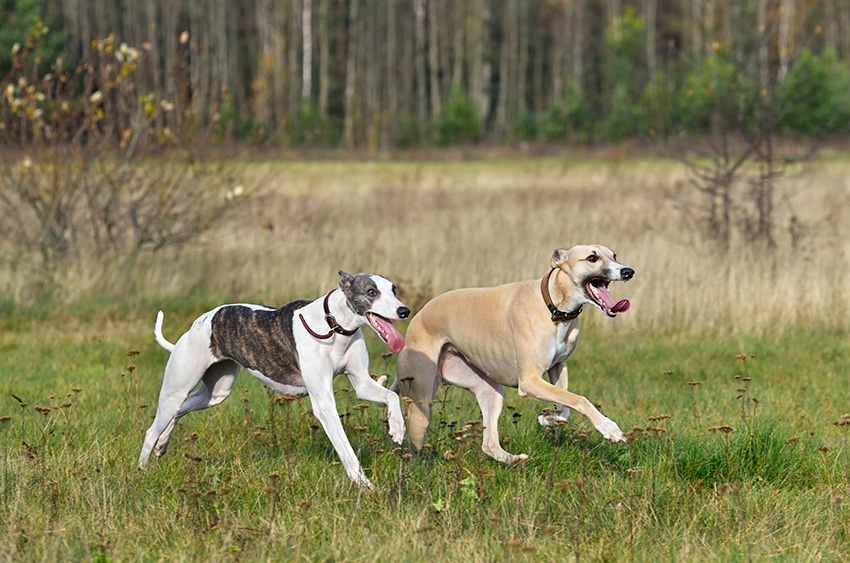
Your four-footed friend may not use words, but he does communicate. Learn to read your dog’s body language so that you know how he’s doing during your runs. Remember that when you bring Fido along as your running partner, you need to pay attention to his cues and needs. Watch the set of his ears and tail, and note his posture.
Reading your pup’s messages can help you know if your pup is having fun or struggling. When you’re around other people or animals, Fido’s body language will also indicate if he’s feeling anxious or uneasy.
Chart Your Course
When you first begin running with your pooch, plan a route that’s close to home. You don’t know how he’ll react to distractions along the course, so it’s best to stay in familiar territory. Map out a safe path for your pooch, and try to use natural trails that are softer and easier on the joints than paved surfaces.
Unless you have a portable water bottle, you may also want to select a route that has drinking fountains or pet-friendly businesses that have water dishes outside. While you’re at it, look for waste cans where you can deposit poop bags if needed.
Develop a Consistent Routine
Dogs, like many children, thrive on routine. Developing a ritual can help your pooch stay calm when he’s anticipating a run. Follow a predictable procedure such as getting on your jacket, harnessing up your pup, and attaching the leash to tell your pooch it’s time to go. Another habit that can relax Fido is to make him sit and wait for you until you’re ready to start.
Consider investing in a special harness that you use only when you go running with your four-legged friend. Not only will this provide a cue to your pup, but it also affords you extra control of your furbaby.
Use a Short Leash
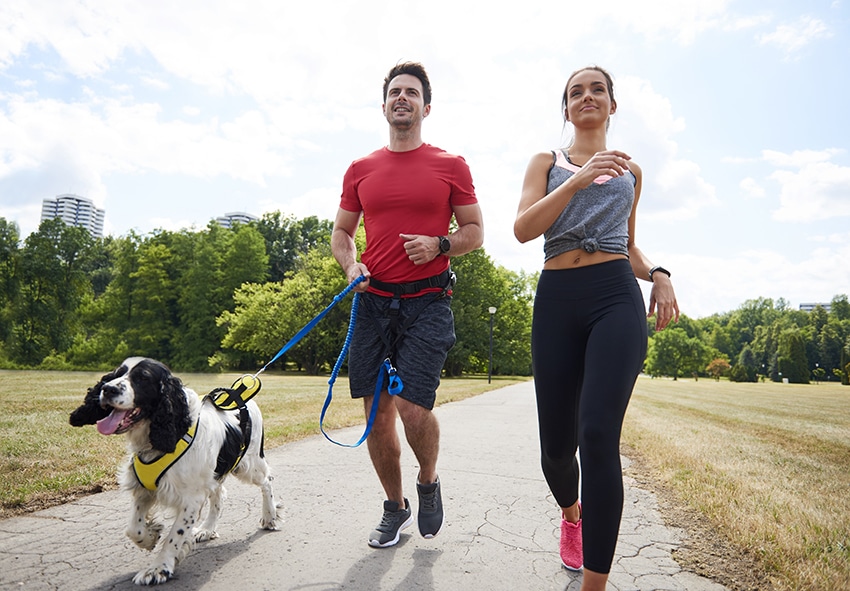
When you’re running with your canine companion, always keep him on a leash. Even a well-trained dog can take off with the right motivation. What’s more, people who don’t know your pup may be afraid if they see a loose dog.
Although retractable leashes are popular, stick with a solid lead for running. Use a relatively short leash for more control. Dogs are more likely to pull if they’re ahead of you, and that can throw off your cadence. Teach your special pal to run by your side.
Be Paw Safe
If you can get blisters while wearing running shoes, think about how vulnerable your dog’s paws can be. It’s imperative that you keep an eye on Fido’s paws when he’s logging the miles with you. Inspect his pads after each run to check for signs of injury such as bleeding, tears, or blistering. If you see any damage, let your pal recuperate until he’s ready to join you again.
Another thing you should do to protect Fido’s feet is trim his nails regularly. Long nails can alter a dog’s gait and cause pain. Properly trimmed claws will not touch the ground when your pup is standing.
Monitor Weather Conditions
Always check the temperature before heading out on a run. This goes for both you and your dog. You need to know what you can do to be safe based on the weather conditions.
On hot days, you can alter your route to run in the shade. Another way to cope is to schedule your outings around dawn or dusk rather than when the sun is at its apex. You should also avoid surfaces that absorb heat from the sun and could burn Fido’s paws.
Likewise, when the temperatures plummet, you’ll need to be cautious. Dogs can lose their balance on ice or other slippery surfaces and sustain an injury. Chemicals such as ice melt may irritate their pads, so clean their feet when you get home.
Generally, fit dogs can run comfortably in temperatures ranging between -10 and 60 degrees F, but there are exceptions. Consult with your veterinarian about the safe zone for your furbaby.
Get Proper Gear
Especially if you’re training for a 10K or marathon, you’ll need to invest in some gear to make running safe and comfortable. In addition to standard supplies such as quality shoes for you and a running harness for your pooch, there are additional accessories to continue depending on weather conditions.
When it’s hot, a cooling vest can help your pup stay cool. To use this device, soak it in cool water then wring it out. Place the vest on your dog and you’ll be ready to go. Bring a water bottle along to stay well-hydrated. You could also plan a route that includes water fountains, but you may need a collapsible water dish for your pal.
In the case of winter weather, you may need a sweatshirt or jacket for your furbaby if he has short hair. After each run, check Fido’s paws for snow or iceballs. These can lodge between the toes and irritate the footpads. Applying a wax-based foot balm to your pooch’s pads help to protect the feet. Another option is to invest in weatherproof booties.
Pick Paw-Friendly Routes
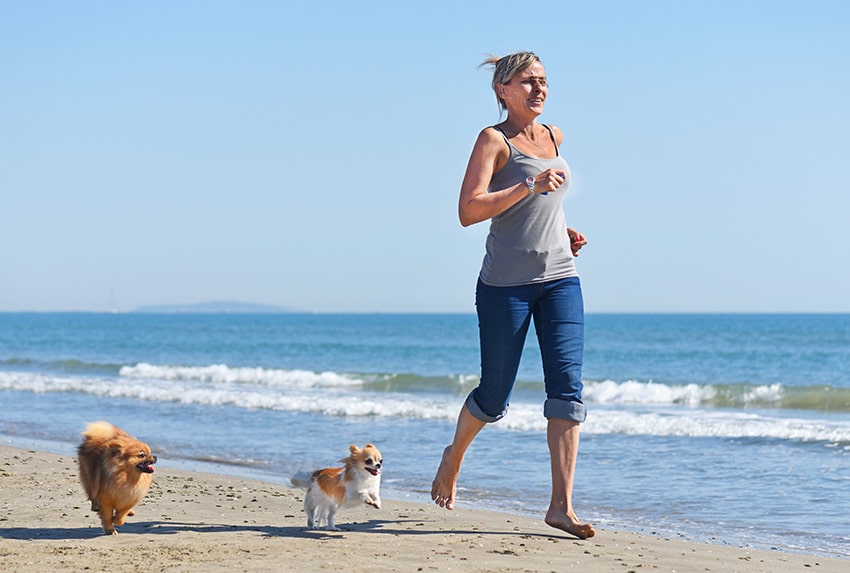
Dogs have sensitive paws. The more cushion you can provide for their feet and joints, the more comfortable they’ll be on long runs. Do your best to plan routes on trails, sandy beaches, forest paths, or through fields and meadows. Watch out for uneven or rocky ground that could cut or bruise the footpads.
Keep A Balanced Diet
You may be wondering if you should feed your pooch more when you take him running. In general, as long as you’re feeding a high-quality diet with about 21-24% protein content, you probably won’t need to increase your pup’s rations. Running 2-3 times a week is not likely to impact his caloric needs. However, if your pooch starts losing weight or is acting more hungry, you can up his food slightly. Just be careful to not overdo it.
There’s another component to Fido’s diet that you’ll want to offer free-choice, and that’s water. Make sure your special pal has plenty of cool liquid before and after your runs. Depending on the temperature and distance of your route, you may also want to take a water break along the way.
Watch for Sore Muscles
Yes, your dog can get sore muscles too. Actually, the way their body metabolizes energy is very similar to humans. So, if your pooch gets up slowly and moves like he’s stiff, you may want to give him a few days off.
Before you reach for your favorite anti-inflammatory to help your furbaby, talk to your vet. Many of the over the counter pain relievers that we use can cause harmful or toxic side effects in dogs. Fido’s doctor can recommend or prescribe a drug that’s suited to your pal’s needs.
You may be able to prevent sore muscles by starting slow. Build your pup’s stamina over time. Remember to start your workout with a gentle warmup to get the muscles ready for more strenuous activity.
What Are You Waiting For?
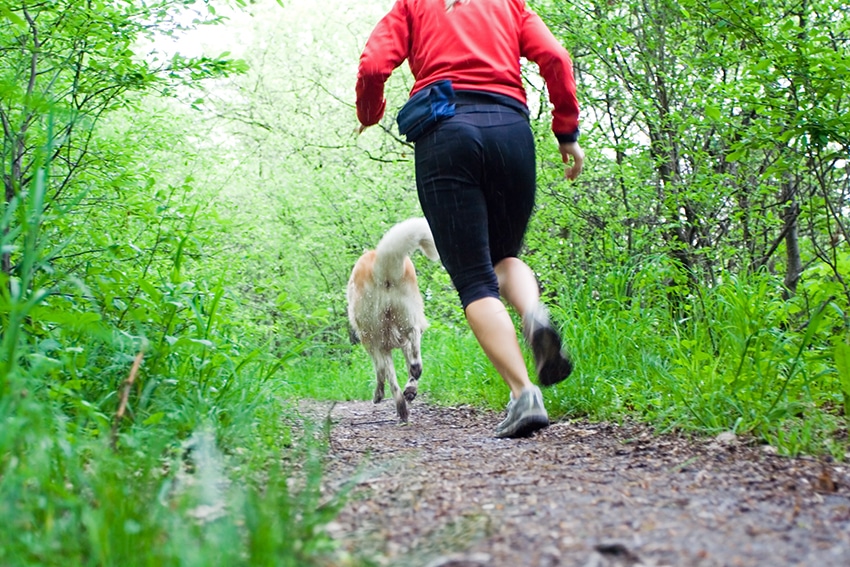
Once you do your homework and train your pooch, you can introduce him to running. So, what are you waiting for? Hit the trails and enjoy sharing your passion with your canine companion!
Feel free to share with us anything else you do to help your furbaby be a faithful running buddy.

